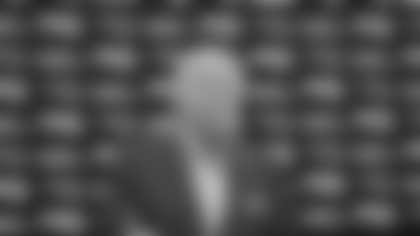[wysifield-embeddedaudio|eid="377676"|type="embeddedaudio"|view_mode="full"]
PATRIOTS HEAD COACH BILL BELICHICK
Q: What have you seen so far this season from Kirk Cousins?
BB:I think he does a lot of things well, seems like a really smart guy who manages the offense well. They have some check plays and things like that. He does a good job there. He's pretty athletic even though he hasn't run a lot, but he moves around quite a bit. They run bootleg moving pocket plays, things like that, so he definitely has quickness to create a little extra time to throw and does a good job of finding and using all his receivers, backs and tight ends and multiple wide-outs. They play a lot of people in the passing game and he can get the ball to them. Definitely spreads it around, they've done a good job of controlling the clock, hitting passes to keep drives going, third down has been good, they're one of the better third-down teams in the league and one of the better red-area teams in the league, so I think that counts a lot for a quarterback to make plays in those situations when the coverage is tight and there is less space to throw. I think he's done a good job for them. Their record is what it is, but they've been in a lot of close games – the overtime game against Atlanta, they were ahead of the Jets at halftime, the Giants game was close, the Miami game was close. I think this is a team that is a lot better than what their record is at this point. They have a lot of guys banged up. It looks like they're going to be getting some of those players back this week. He's done a good job with them. They have a good team, and it sounds like they're going to be a lot stronger here in the coming weeks.
Q: When you're facing a good third-down team, what are the keys to attacking them?
BB:I think a lot of their success on third down is related to their success on first and second down – strong running game, again a lot of the West Coast passing style along with some bootlegs and moving pocket plays and that kind of thing. They get on track a lot – second-and-four, second-and-three, second-and-five – and then you're looking at having two downs to pick up four or five yards – that kind of thing. I think it all starts on first down to get a team into third down and longer type situations where they have fewer options in the passing game, like everybody. But they do a good job of running the ball and they do a good job of hitting a high number of percentage passes so they stay out of a lot of long-yardage situations, haven't been sacked very much, so they don't have a lot of bad plays.
Q: You guys were much improved on third down against the Dolphins. Was there anything differently you did to prepare for that game or was it a matter of being better on first and second downs?
BB:I think that did help us a little bit, but we had the Jets in a lot of long yardage situations that we couldn't convert in. I just think overall our execution on third down as a team was better and it needs to be better from every standpoint – the pass rush, the leverage on the quarterback, keeping him in the pocket and attacking the pocket, maintaining our coverage leverage, whatever it is, inside or outside or being where we're supposed to be and using our help and being disciplined enough to do that if a pattern develops. I thought our execution was better last week, but we can still improve on that, too. But it's a team thing. I don't think it's any one guy that has been responsible for any significant amount of production any more than anybody else has. We all have to coach it better and play it better and be more disciplined to follow through with all the little – well they're not little – but little things, all the little assignments that are a part of the play to make it successful. When one thing breaks down, you could be doing other multiple things right, but the results aren't good.
Q: What are your thoughts on Jay Gruden and given his quarterback background, what do you think went into his decision to play Kirk Cousins over Robert Griffin III?
BB:I really don't know. I'm sure Coach Gruden made the decision that he felt worked best for the team and I totally respect that, so whatever they are, that's something that he and his staff … But we have to be ready for everybody and we will. We'll be ready for all the players that are on the active roster. I would say overall that this is a pretty balanced team. They run the ball with a good frequency and some of their rushing, like everyone's, is a little bit circumstantial. When they fell behind in a couple games, the rushing numbers dropped, but when they've been able to be in the situation they want to be in, they're running the ball pretty close to 50 percent of the time, so that can get skewed in a game or get skewed in the overall season stats when you have a couple games where you're playing from behind. Even the Tampa game was one they won, but they were playing from behind most of that game. But I think their balance is good. I think they have a very good rushing game. They have excellent backs, they have a good offensive line and they have a good complementary group of play action passes to go with the running game, so even though I know they're pass plays but they really tie so closely into the running games – all the bootlegs and misdirection plays and things like that – if you're stopping one it's hard to stop the other. They do a real good job of tying those together. I think the offense has a lot of complementary components to it. They do a good job.
Q: They tried an onside kick in the Tampa Bay game. Do they have a tendency to gamble a little bit or do the unexpected?
BB: Well, yeah, I mean I think there are some aggressive plays. They're a very good kick blocking team. They rush a number of punts. We're going to definitely get plenty of those. Again, I think those fake punts or onside kicks or whatever, if you have the right look, you have it set up the way you want it and you execute it well, that it's a good play and it certainly keeps your future opponents on their toes in that area over the next several weeks, and that may benefit you in some other way because they're concerned about that and then you're able to hit on other things. We've always got to be alert for that, but they're aggressive and I don't think you can ever count them or most teams out. If you're not sound and you're not alert in what you're doing on fake punts, onside kicks, fake field goals, or the same thing in coverage. With them if you just break down your lane coverage and like what happened to us last week in the Miami game, [Rashad] Ross can take it all the way and DeSean Jackson is obviously as good of a big play guy as there is in the league. You've got to be sound in that phase of the game, too.
Q: Some of your former offensive linemen have said that you required them to wear knee braces when they were with the team. Was there something that happened in your coaching career that made you decide that was the best decision?
BB: The braces that the players where now are a little different than the braces that I think we first started wearing back in the 80's when I was with the Giants and then at Cleveland, and they were kind of like a steel hinge that was usually taped or wrapped to the side of the knee as opposed to those bigger, DonJoy braces that most guys wear now. So, I can remember on multiple occasions seeing the brace like literally bend in half or not maybe in half but bent significantly, so that it had taken a blow and the brace bent and the player maybe had a minor injury or a low MCL sprain or something like that. And the braces were strong. Had they not taken that blow and protected the player, you have to imagine the injuries would be a lot worse. I think that was a pretty vivid image that I had, and we did that with the players as well, too. When that happened, in a meeting I'd just hold the brace up and say, "Well it's fortunate that so-and-so was wearing this protective brace. It looks like he might miss a week or two or maybe he isn't going to miss any time at all but I think we can all picture a more severe injury if he didn't have this protective equipment on." So, that type of thing. The braces now, just the way they're constructed they're really not conducive to that type of a visual example, but you still see plays on film where guys get hit in a way that it looks like it's going to be a pretty bad injury and then it isn't as bad as it looks and I'm sure part of that is the protective equipment.
Q: Have you ever had a player come to you and say that they don't want to wear a brace because it's affecting them negatively?
BB: Sure, yeah, I've had a lot of conversations with a lot of players over 41 years on various subjects, including that – yeah, sure.
Q: How have you felt about Sebastian Vollmer's transition to left tackle, and how big of a switch is that for a player?
BB:I think Sebastian has done a good job for us. I think it is a tough switch. It's kind of going from doing everything one way – all your footwork and punching and leverage and everything you do and then flipping it over and doing it the exact opposite way. From a technique standpoint, it's definitely challenging on top of the fact that you're working with different people on the other side of the line and there's that timing and being able to see things the same as the person next to you, but it's a different person and sometimes we all see the same thing just a little bit differently. Getting all that together, it takes time, it takes work, it's not easy, but I think all that being said, he's done a great job of making that transition over there the last couple weeks. We've really needed him to do that. Sebastian is one of the best teammates, a guy who always puts the team first as much as anybody we have on our team. He's done that and done a good job of it for having had minimal practice at it, a few training camps and so forth. But he works hard and we've definitely been able to maintain a lot of our offensive production, so that's been good.
Q: With Australian punters coming into the league, has the teaching and philosophy of when to field punts changed, or do you still tell your returners to stand on the 10-yard line and if it goes over your head let it go?
BB: That's a really good question and I think there are a lot of factors that go into the coaching of that positon and that situation that you described, but among the things that the returner has to consider is where the ball is being punted from and how close the coverage is to him and how apt they are or what kind of position they're in to be able to down those balls. We've all seen a lot of plays where the returner runs out of the way and the coverage player comes down there, turns around and catches the ball on the three-yard line or whatever. I think it's definitely a challenging situation. First of all, it's a lot different when a punter punts the ball from his own 40 and the ball is carrying 55 yards and hits on the five-yard line from when he's on your 40 and the ball is being punted straight up in the air and it comes down on the five-yard line. The trajectory of the ball and as you mentioned the technique of punting it where it has a backspin if you will or kicked in a way that it's less likely to bounce forward, then you've got to think about catching the ball inside the 10 as opposed to letting it be downed on the one or two and the chances of it going into the end zone are probably not very good. So, there is that whole situation. I think a good returner can tell by the way the ball is traveling, not that you can predict at 100 percent, but you can get a pretty good idea if it's going to bounce or if it's going to kick backwards based on the way the ball is spinning. So that can play into it. The wind can play into it. And then there is the whole philosophy like we talked about before with kickoff returners that if you have a great returner, and you handle the ball, assuming that you don't fumble it, that you handle the ball in that kind of situation, what's the risk and what's the reward. You might lose a few yards of field position versus giving that player an opportunity to return a kick and possibly make a big play. So are you willing to trade a few yards of field positon for an opportunity at an explosive play and handling the ball, and I think that a lot more returners are given the green light on that maybe than what they were in decades earlier let's call it. I think that's part of the equation, too, taking your returner out of the game just because the ball goes inside the 10-yard line, not saying that's wrong, but it's also a decision you're making to limit the playmaking ability of potentially one of your explosive players. Long answer to a short question, a lot of different factors, I think every team probably gives their returner certain guidelines. I think the more trust and confidence and experience that player has, the more willing you are to let him make the right decision based on the actual kick and what happens on that play as opposed to just a generic set of rules. And then there are some situations that are cut and dry, depending on the score, time and situation of the game, there is not really a decision to make. Here's the way it is and we follow those rules. But it's certainly an interesting point of discussion, and I don't know that there's any right or wrong answer to it other than whatever has been identified and communicated to the returner by the team. But there is certainly variability on that subject.
Q: When you drafted Nate Ebner, what was the thinking of what he would be able to bring to the team at some point?
BB: Well, we liked a lot of things about him in terms of his ability and production in the kicking game at Ohio State. He didn't have a lot of defensive playing experience there, but in the time we've had him I think he has played for us at various points in his career and I think that he has the ability to do that as well. It's a very competitive position for us at this point in time. So that was something that we didn't have an evaluation of then that we have a lot better evaluation of now. But he was a very productive player for Ohio State in a similar role that he has now, so I would say that was probably the big thing with that.
Q: Considering all the injuries, can you address the work of the offensive line through the first seven games?
BB: I think our offensive line and Coach Gug [Dave DeGuglielmo] and Coach [Josh] McDaniels have done a good job of again building our depth in preseason, where we had guys play multiple positons so that we can take seven linemen to a game and support all five positions and be able to do different things offensively. And the guys have worked very hard with each other and individually on their own fundamentals and techniques to be prepared and execute all the different plays and assignments and block all the different types of players that we face. It's a hard working group. It's a group that takes a lot of pride in what they do. They spend a lot of time together, they care and support each other, and it's great to see them having positive results from all their hard work.
[wysifield-embeddedaudio|eid="377681"|type="embeddedaudio"|view_mode="full"]
OFFENSIVE COORDINATOR JOSH MCDANIELS
Q: How impressive has the offensive line been despite injuries?
JM:Well, I think that's pro football. It happens to a lot of guys each year. That's why we preach versatility and trying to know as much as they can know about the whole scheme in general or the entire offense or whatever they're position group might be because we know at some point we're not going to have enough backups to just keep putting another guy in. We might have to move somebody or adjust something so that we can continue to play, and the offensive linemen know that that's part of their responsibility. You can't just, you know, it's hard to be a one-position player in this league, especially when you can only take usually seven to the game. You need to have some guys that have some versatility. Gug [Dave DeGuglielmo] has done a great job of getting those guys prepared to go. We know we have enough healthy bodies each week to go out there and practice and do the things we need to do at each position, and we try to manage it the best that we can. We get the guys the repetitions that they need so that they're prepared and ready to play by the time game day rolls around. So the players always deserve the credit for that. They put a tremendous amount of time and effort into learning different positions, studying opponents. That's another area that goes kind of unspoken. When you go from one side, whether it's a guard or tackle, to playing another position, you're dealing with a bunch of different defensive players, different defensive schemes, different offensive calls that may be made between a lineman here on the left side, now all of a sudden you're making a different one over here on the right side. So it's not easy, but it's a part of our responsibility. And the players have embraced it, and we always try to do the best we can to prepare them each week. And they go out there ready to go, and give us everything they have.
Q: How impressed have you been with how seamless it's been?
JM:Well, it's not seamless, that's for sure. There's a lot of time and effort that's put into whatever it is that we do. We play a good opponent each week that presents a tremendous amount of challenges. This one is no different – the Redskins. [They do] a lot of different things that we haven't seen or played against this year, which will be challenging in many ways. But look, I think your attitude going into every situation is really an important thing. We always have a positive frame of mind, a positive outlook on things. We accept and embrace the responsibility that we have to get ready and play. We have no excuses, never, no matter what adversity or what may be staring anybody in the face. Every team deals with injuries. Every team deals with players that may have to switch positions, and we're no different. We just want to work hard and get ready to play each week and try to do the best that we can on Sunday.
Q: How have you seen Tom Brady work on his arm strength throughout the course of the year?
JM:I certainly don't have any figures to back me up on that, but I think that he certainly does everything in his power to take care of his body, to make sure that his shoulder and his arm and his hips and his core, his legs, all the things he uses to get velocity on the ball – I think he does a tremendous job of making sure that those things are well taken care of during the course of the entire year, not just football season. He certainly comes in and does his work, whether it's strength and conditioning, flexibility, rehab, all of those things, nutrition. All of those things play into it. And I've been around him for a long time, and there's, certainly not to my knowledge, been any drop off in any of those things relative to Tom throwing the football – velocity, touch, accuracy, ability to do some things on the run. He's always trying to get better in those areas of his game, and certainly, like I said, I think that he deserves a tremendous amount of credit for maintaining and improving in all of those areas as he's gone through his career.
Q: What goes into coordinating the timing between the tight ends and the running back when two tight ends are blocking?
JM:A lot of repetition, and I think whether it's the running game or pass protection or pass routes, timing in the passing game, waiting for a pulling guard, whatever it may be, I think you first have to have an understanding of the scheme and what we're attempting to do. I think you'd like everybody to know what the other players are doing or responsible for on each play so they have an idea of when and what may be occurring based on the look that we're getting. And I think that ultimately if it's a run play like that, you try to give the back an opportunity to get to the line of scrimmage and make somebody miss at some point because you've done a good job to try and block the people who are in and around the box as best we can. So some of those plays we use tight ends, some of them it's just one, sometimes we go away from the tight ends. There are a lot of different blocking combinations, but I think the running game in general comes down to execution of assignment and then just timing and the back having an understanding of what his read is. And then wherever his read takes him, then hopefully we can do the best we can with blocking the play properly so that we give him an opportunity to make yards through the line of scrimmage.
Q: What do you see from Washington's defense? How does requiring the offensive linemen to wear knee braces protect them from injury?
JM:I'll start with the last one. I think the knee braces are great. Look, the most important thing for us is the health of the players, and if there's something that we could do to help protect them in a game that obviously has enough injuries as it is, then I think it's worthwhile. I don't think it's a big hassle to do that in either practice or games, and I think it's a very good precaution to take. I don't know that we'll ever know how many injuries we've prevented, but hopefully you're putting guys in a position where they can withstand a fall or an awkward pile or something and then come back and continue to play. So I would suggest it and certainly recommend it. I'm all for it because I think it helps our guys stay healthy. The Redskins, this is a very physical group. They've got great size up front. This is going to be a big challenge for us relative to their front four and many times, I call it their front eight because they drop a safety down in the box quite a bit. There are a lot of guys down in there. They do a good job of trying to overload you relative to numbers, and they're a big powerful group with great size. We're going to need to do a good job of playing physical and trying to stand up to this front. They've created 14 fumbles this year, which I think is third in the league. They really try to do a good job of trying to strip the ball off of people. They've created three or more turnovers in multiple games this season, which certainly is an area we talk a lot about. We're going to need to do a great job of taking care of the football this week. And it's a team that does a good job of stopping people in the red zone, good in short yardage. They've got a lot of players who relative to injuries have played some time, and we've got a lot of guys on film that we need to get familiar with because we're not 100 percent sure who will or won't play a certain percentage of the game. But we've got a lot of guys we're getting familiar with right now. They've got two really good edge rushers who can player there on the edge, [Ryan] Kerrigan and [Trent] Murphy, and they're very athletic at linebacker. We've got, again, these weeks where we're playing an opponent that we don't have tremendous familiarity, we have a lot of responsibility to get caught up on their personnel, to know the identity of the group we're playing. And this group is certainly well-coached, does a good job of playing within their scheme and challenges you in some different ways in that regard, too, and definitely, certainly is after the football in any way that they can get it. So we're going to need to have a great week of preparation and practice and hopefully go out there and play our best on Sunday.
[wysifield-embeddedaudio|eid="377686"|type="embeddedaudio"|view_mode="full"]
DEFENSIVE COORDINATOR MATT PATRICIA
Q: Against Tampa Bay, Washington came out with some unique groupings of three and four wide receivers. Is that something you've seen before and could you talk a bit about what you've seen from Kirk Cousins?
MP:Sure, well I mean I think Washington with the sets that you're talking about, that is something that we've definitely seen with the empty sets where they'll try to stick four receivers to one side and a single receiver to the back side. Obviously it's a formation look where they're trying to see how you're going to play versus the overloaded formation, what's it look like on the back side, what does the front side look like, what's the numbers in the coverage relative to the amount of receivers that they can put out into the pattern. It's another way to take and stretch you from a defense, from a horizontal standpoint and really create a lot of space to throw the ball both front side and back side, and you know, try and use the formation that they did to create some opportunity for those guys to either rub off each other or free release or get some crossing routes out of it. [It's] definitely a difficult scheme, something that's incorporated in their offense that you do see and you do see in offenses nowadays where they're trying to get everybody out into patterns and really put the defense in an unfavorable situation based on the numbers that they put out into the pattern. As far as Kirk Cousins, I think Coach [Belichick] did a great job as far as explaining just how disciplined he's been and what a good job he's done from just really running this offense and controlling the clock and managing the game and getting the ball out to a numerous amount of receivers, being able to run the run game with the different alerts and checks that they have that go along with it and controlling the clock, not really putting them in a lot of negative plays and then obviously converting in the third-down and red-area situations that Coach talked about. He's done just an excellent job this year of having that all handled.
Q: Is there an emphasis on stopping them on the early downs due to their third-down success?
MP:Well I think tying all the down and distances together you're going to try and do whatever you can on the early down situations to make sure they don't gain any yardage, whether it's a particular call or a particular play. You want to make sure that defensively you're sound and that there's not a problem where they can gain big yardage on early downs and obviously put themselves in a situation where third down is a very manageable situation. I would say all of our calls are designed to hopefully stop them on early downs, whether it's a coverage, pressure, blitz – whatever you want to call it. I think all of those are used in appropriate situations to try to prevent the offense from gaining any yards. We're certainly trying to match up with what they do on early downs and handle all the different things that we can see and hopefully we get some plays there where we create some negative plays. Then we've just got to be able to handle whatever down and distance comes up, whether it's third-and-short, third-and-long, third-and-medium. Our job is to get off the field and handle those situations, so that's really what we're looking at.
Q: Is Washington capable of deceiving teams with their horizontal schemes and then coming over the top with their vertical plays?
MP:Yeah, it's a great question, and I think you're exactly right. I think they do a good job of really mixing in – number one – the run game and their ability to really run the stretch-run combination with the zone and the power scheme that you do see, but that running ability that creates the play action and boot game or the move-the-pocket-type of passes that Coach was talking about earlier. Those are definitely a conflict for the defense to handle and then they do a great job of mixing the short, horizontal game with the vertical stretch. They time it up very well. They also mix that in with the play action to get the ball downfield along with the drop back pass game. They have vertical speed and their receivers, they have big receivers and they have fast receivers, so certainly a guy like DeSean Jackson who can just flat out fly and go vertical and [Rashad] Ross when he's in there, those guys that can push the ball vertical along with the tight end, [Jordan] Reed, who's just a really, really good player for these guys, does a great job, he can get vertical, he makes big plays. Those guys, it's a really balanced, well managed offense where they have the great combination of run game, play action, and boot along with the horizontal, quick-timing throws that are mixed in with the vertical-type, shot-down-the-field situations. It's very balanced. It's very complementary to each other, all the plays, and that's where they do create those big plays downfield.
Q: How advantageous has it been for the defense to start with the opponent backed up in their own territory?
MP:Well, I think with field position in general, you give credit to the guys that are out there in the special-teams situations and the guys that are being able to create that. For us defensively, whatever the situation is we have to go out and handle it. We have to play to it and be able to stop it no matter what it is. We have to make sure that we just understand what that situation is, wherever the ball is placed on the field and whatever the down and distance is on third down it doesn't really matter to us. We've just got to make sure that we can perform and hopefully recognize what they're doing and stop those plays that they're giving us. That's really more of what we focus on.








































